Economic Analysis of Newspaper Article: Australian Car Manufacturing
VerifiedAdded on 2020/03/04
|6
|1299
|36
Report
AI Summary
This report analyzes a newspaper article discussing the challenges faced by car manufacturing companies in Australia, including Mitsubishi, Ford, Holden, and Toyota. The central issue is the high cost of production, driven by factors such as high labor costs, unfavorable import tariffs, free trade agreements, and an appreciating Australian dollar, leading these companies to consider relocating their assembly lines. The analysis explores the stakeholders involved, including the companies, suppliers, workers, and the R&D sector. It examines the government's role in creating regulations and quotas that interfere with market equilibrium and the impact of labor unions on production costs. The report suggests potential solutions for the car manufacturing companies, such as reducing the number of platforms and increasing economies of scale, and proposes government interventions like tax incentives and support to protect the industry and its workforce. The report highlights the potential economic consequences if these companies exit the Australian market, including increased unemployment and damage to the R&D sector.
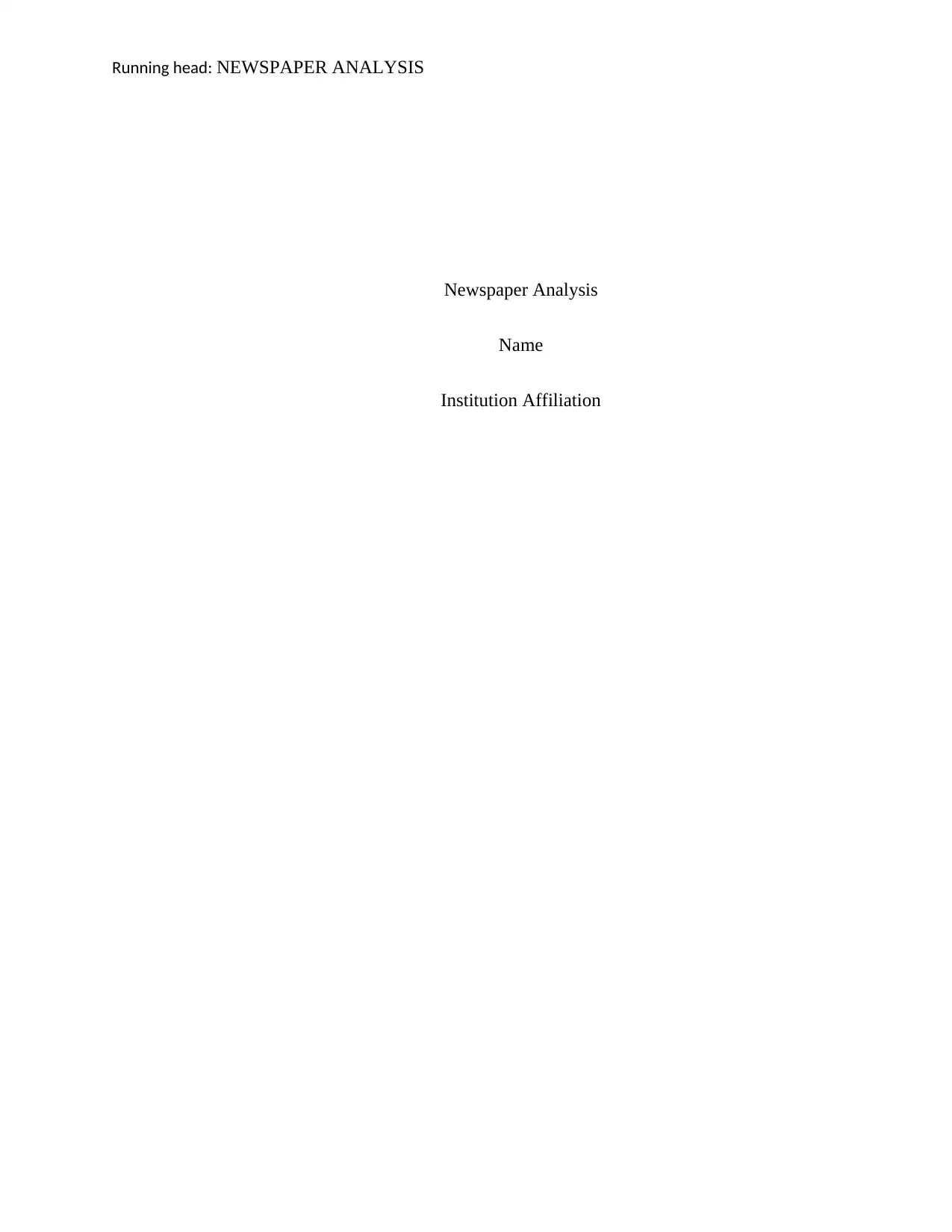
Running head: NEWSPAPER ANALYSIS
Newspaper Analysis
Name
Institution Affiliation
Newspaper Analysis
Name
Institution Affiliation
Paraphrase This Document
Need a fresh take? Get an instant paraphrase of this document with our AI Paraphraser
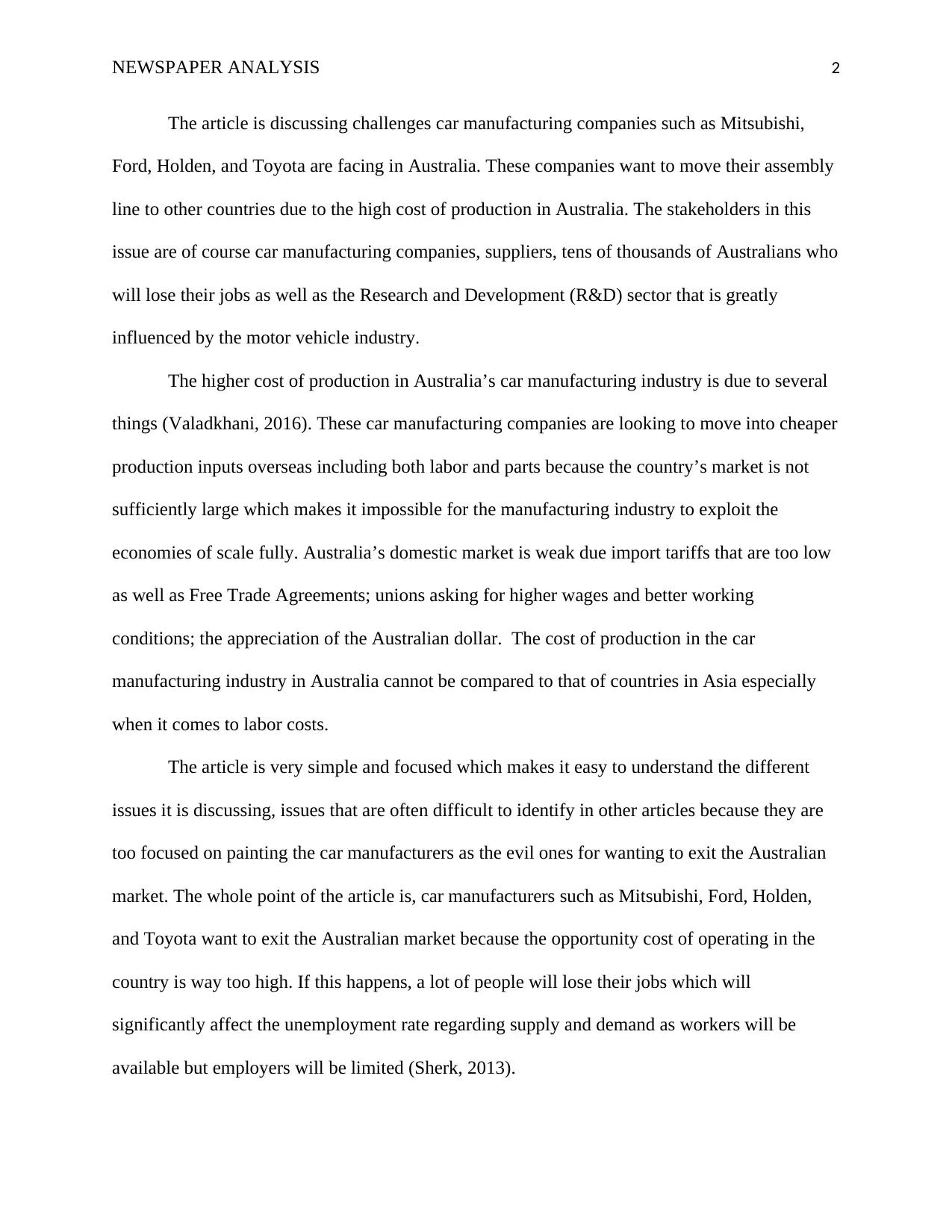
NEWSPAPER ANALYSIS 2
The article is discussing challenges car manufacturing companies such as Mitsubishi,
Ford, Holden, and Toyota are facing in Australia. These companies want to move their assembly
line to other countries due to the high cost of production in Australia. The stakeholders in this
issue are of course car manufacturing companies, suppliers, tens of thousands of Australians who
will lose their jobs as well as the Research and Development (R&D) sector that is greatly
influenced by the motor vehicle industry.
The higher cost of production in Australia’s car manufacturing industry is due to several
things (Valadkhani, 2016). These car manufacturing companies are looking to move into cheaper
production inputs overseas including both labor and parts because the country’s market is not
sufficiently large which makes it impossible for the manufacturing industry to exploit the
economies of scale fully. Australia’s domestic market is weak due import tariffs that are too low
as well as Free Trade Agreements; unions asking for higher wages and better working
conditions; the appreciation of the Australian dollar. The cost of production in the car
manufacturing industry in Australia cannot be compared to that of countries in Asia especially
when it comes to labor costs.
The article is very simple and focused which makes it easy to understand the different
issues it is discussing, issues that are often difficult to identify in other articles because they are
too focused on painting the car manufacturers as the evil ones for wanting to exit the Australian
market. The whole point of the article is, car manufacturers such as Mitsubishi, Ford, Holden,
and Toyota want to exit the Australian market because the opportunity cost of operating in the
country is way too high. If this happens, a lot of people will lose their jobs which will
significantly affect the unemployment rate regarding supply and demand as workers will be
available but employers will be limited (Sherk, 2013).
The article is discussing challenges car manufacturing companies such as Mitsubishi,
Ford, Holden, and Toyota are facing in Australia. These companies want to move their assembly
line to other countries due to the high cost of production in Australia. The stakeholders in this
issue are of course car manufacturing companies, suppliers, tens of thousands of Australians who
will lose their jobs as well as the Research and Development (R&D) sector that is greatly
influenced by the motor vehicle industry.
The higher cost of production in Australia’s car manufacturing industry is due to several
things (Valadkhani, 2016). These car manufacturing companies are looking to move into cheaper
production inputs overseas including both labor and parts because the country’s market is not
sufficiently large which makes it impossible for the manufacturing industry to exploit the
economies of scale fully. Australia’s domestic market is weak due import tariffs that are too low
as well as Free Trade Agreements; unions asking for higher wages and better working
conditions; the appreciation of the Australian dollar. The cost of production in the car
manufacturing industry in Australia cannot be compared to that of countries in Asia especially
when it comes to labor costs.
The article is very simple and focused which makes it easy to understand the different
issues it is discussing, issues that are often difficult to identify in other articles because they are
too focused on painting the car manufacturers as the evil ones for wanting to exit the Australian
market. The whole point of the article is, car manufacturers such as Mitsubishi, Ford, Holden,
and Toyota want to exit the Australian market because the opportunity cost of operating in the
country is way too high. If this happens, a lot of people will lose their jobs which will
significantly affect the unemployment rate regarding supply and demand as workers will be
available but employers will be limited (Sherk, 2013).
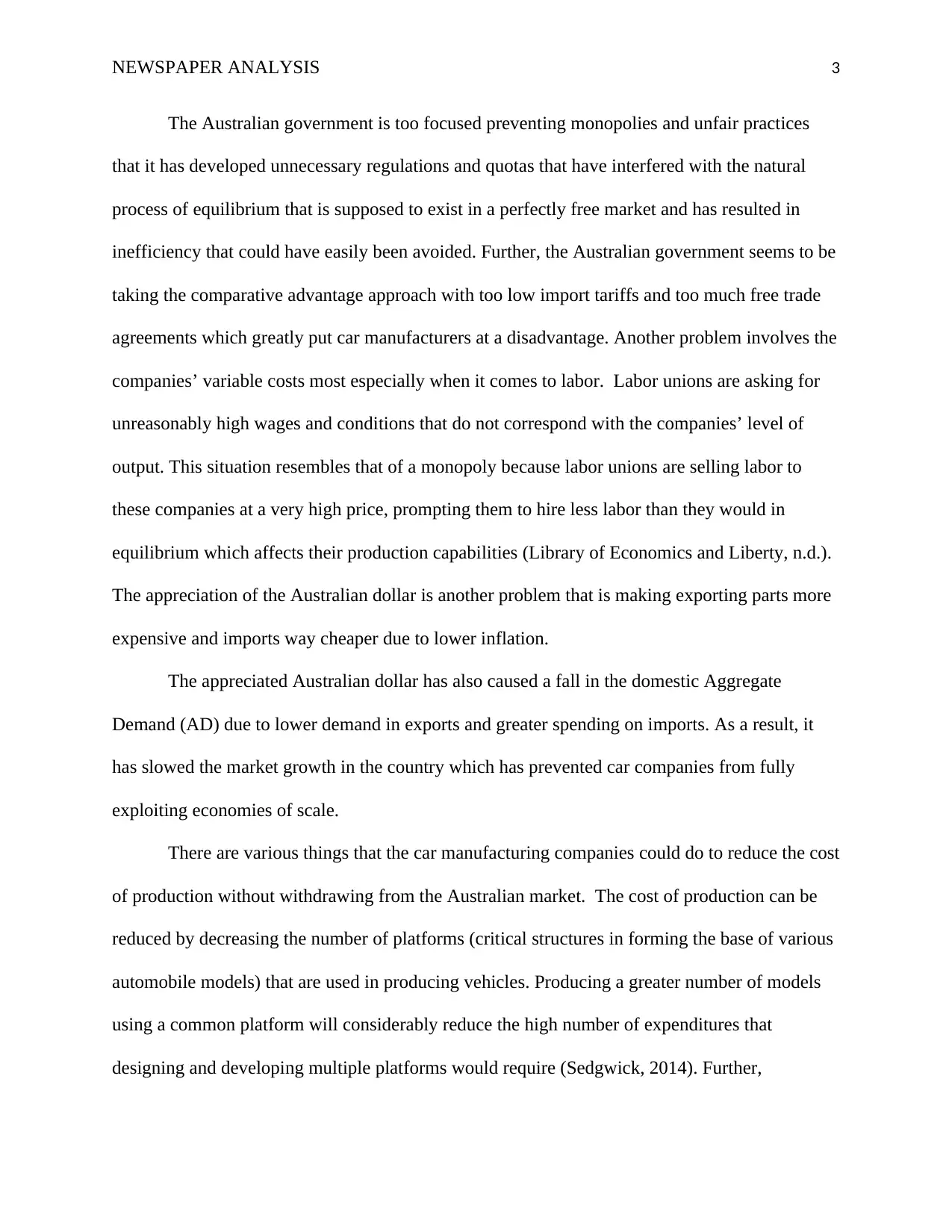
NEWSPAPER ANALYSIS 3
The Australian government is too focused preventing monopolies and unfair practices
that it has developed unnecessary regulations and quotas that have interfered with the natural
process of equilibrium that is supposed to exist in a perfectly free market and has resulted in
inefficiency that could have easily been avoided. Further, the Australian government seems to be
taking the comparative advantage approach with too low import tariffs and too much free trade
agreements which greatly put car manufacturers at a disadvantage. Another problem involves the
companies’ variable costs most especially when it comes to labor. Labor unions are asking for
unreasonably high wages and conditions that do not correspond with the companies’ level of
output. This situation resembles that of a monopoly because labor unions are selling labor to
these companies at a very high price, prompting them to hire less labor than they would in
equilibrium which affects their production capabilities (Library of Economics and Liberty, n.d.).
The appreciation of the Australian dollar is another problem that is making exporting parts more
expensive and imports way cheaper due to lower inflation.
The appreciated Australian dollar has also caused a fall in the domestic Aggregate
Demand (AD) due to lower demand in exports and greater spending on imports. As a result, it
has slowed the market growth in the country which has prevented car companies from fully
exploiting economies of scale.
There are various things that the car manufacturing companies could do to reduce the cost
of production without withdrawing from the Australian market. The cost of production can be
reduced by decreasing the number of platforms (critical structures in forming the base of various
automobile models) that are used in producing vehicles. Producing a greater number of models
using a common platform will considerably reduce the high number of expenditures that
designing and developing multiple platforms would require (Sedgwick, 2014). Further,
The Australian government is too focused preventing monopolies and unfair practices
that it has developed unnecessary regulations and quotas that have interfered with the natural
process of equilibrium that is supposed to exist in a perfectly free market and has resulted in
inefficiency that could have easily been avoided. Further, the Australian government seems to be
taking the comparative advantage approach with too low import tariffs and too much free trade
agreements which greatly put car manufacturers at a disadvantage. Another problem involves the
companies’ variable costs most especially when it comes to labor. Labor unions are asking for
unreasonably high wages and conditions that do not correspond with the companies’ level of
output. This situation resembles that of a monopoly because labor unions are selling labor to
these companies at a very high price, prompting them to hire less labor than they would in
equilibrium which affects their production capabilities (Library of Economics and Liberty, n.d.).
The appreciation of the Australian dollar is another problem that is making exporting parts more
expensive and imports way cheaper due to lower inflation.
The appreciated Australian dollar has also caused a fall in the domestic Aggregate
Demand (AD) due to lower demand in exports and greater spending on imports. As a result, it
has slowed the market growth in the country which has prevented car companies from fully
exploiting economies of scale.
There are various things that the car manufacturing companies could do to reduce the cost
of production without withdrawing from the Australian market. The cost of production can be
reduced by decreasing the number of platforms (critical structures in forming the base of various
automobile models) that are used in producing vehicles. Producing a greater number of models
using a common platform will considerably reduce the high number of expenditures that
designing and developing multiple platforms would require (Sedgwick, 2014). Further,
⊘ This is a preview!⊘
Do you want full access?
Subscribe today to unlock all pages.

Trusted by 1+ million students worldwide
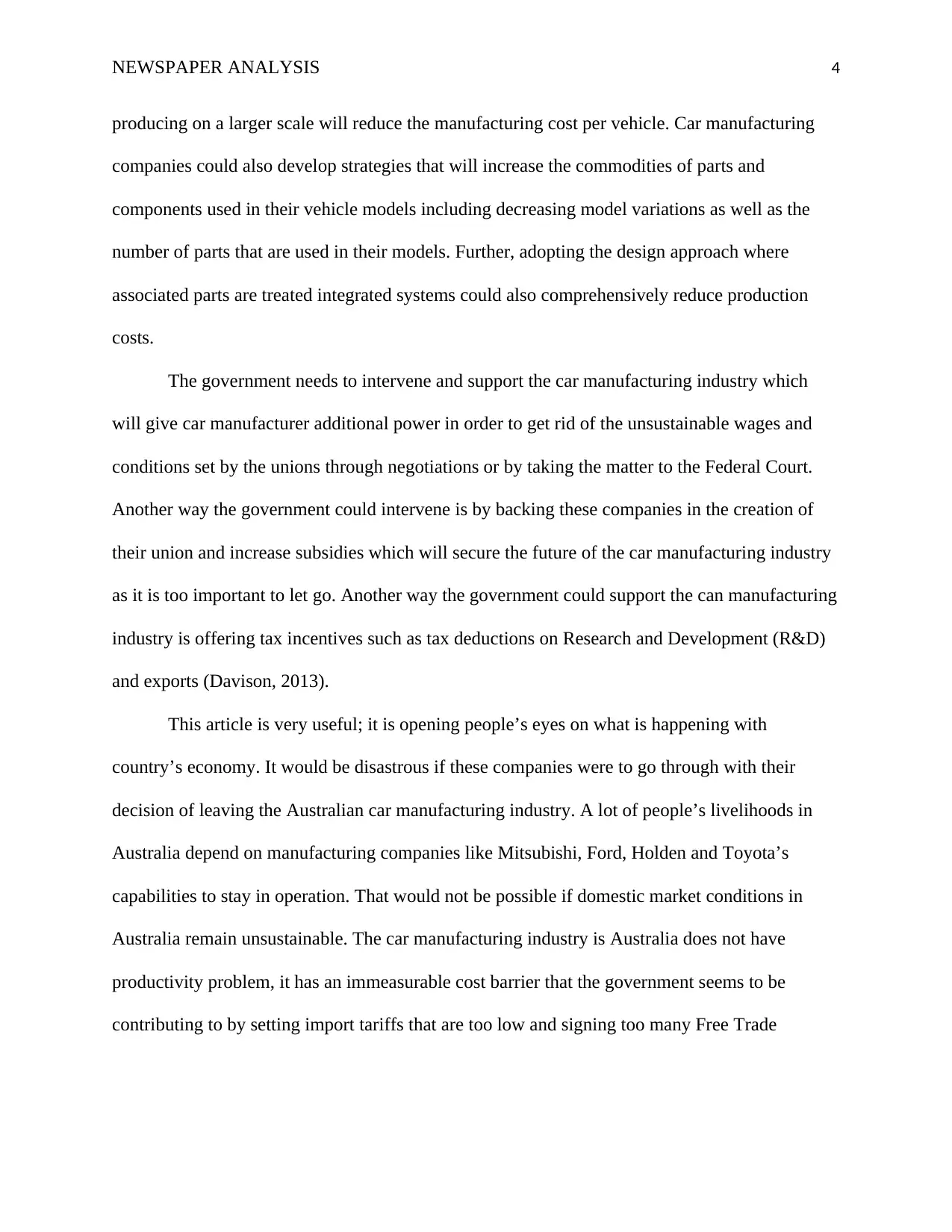
NEWSPAPER ANALYSIS 4
producing on a larger scale will reduce the manufacturing cost per vehicle. Car manufacturing
companies could also develop strategies that will increase the commodities of parts and
components used in their vehicle models including decreasing model variations as well as the
number of parts that are used in their models. Further, adopting the design approach where
associated parts are treated integrated systems could also comprehensively reduce production
costs.
The government needs to intervene and support the car manufacturing industry which
will give car manufacturer additional power in order to get rid of the unsustainable wages and
conditions set by the unions through negotiations or by taking the matter to the Federal Court.
Another way the government could intervene is by backing these companies in the creation of
their union and increase subsidies which will secure the future of the car manufacturing industry
as it is too important to let go. Another way the government could support the can manufacturing
industry is offering tax incentives such as tax deductions on Research and Development (R&D)
and exports (Davison, 2013).
This article is very useful; it is opening people’s eyes on what is happening with
country’s economy. It would be disastrous if these companies were to go through with their
decision of leaving the Australian car manufacturing industry. A lot of people’s livelihoods in
Australia depend on manufacturing companies like Mitsubishi, Ford, Holden and Toyota’s
capabilities to stay in operation. That would not be possible if domestic market conditions in
Australia remain unsustainable. The car manufacturing industry is Australia does not have
productivity problem, it has an immeasurable cost barrier that the government seems to be
contributing to by setting import tariffs that are too low and signing too many Free Trade
producing on a larger scale will reduce the manufacturing cost per vehicle. Car manufacturing
companies could also develop strategies that will increase the commodities of parts and
components used in their vehicle models including decreasing model variations as well as the
number of parts that are used in their models. Further, adopting the design approach where
associated parts are treated integrated systems could also comprehensively reduce production
costs.
The government needs to intervene and support the car manufacturing industry which
will give car manufacturer additional power in order to get rid of the unsustainable wages and
conditions set by the unions through negotiations or by taking the matter to the Federal Court.
Another way the government could intervene is by backing these companies in the creation of
their union and increase subsidies which will secure the future of the car manufacturing industry
as it is too important to let go. Another way the government could support the can manufacturing
industry is offering tax incentives such as tax deductions on Research and Development (R&D)
and exports (Davison, 2013).
This article is very useful; it is opening people’s eyes on what is happening with
country’s economy. It would be disastrous if these companies were to go through with their
decision of leaving the Australian car manufacturing industry. A lot of people’s livelihoods in
Australia depend on manufacturing companies like Mitsubishi, Ford, Holden and Toyota’s
capabilities to stay in operation. That would not be possible if domestic market conditions in
Australia remain unsustainable. The car manufacturing industry is Australia does not have
productivity problem, it has an immeasurable cost barrier that the government seems to be
contributing to by setting import tariffs that are too low and signing too many Free Trade
Paraphrase This Document
Need a fresh take? Get an instant paraphrase of this document with our AI Paraphraser
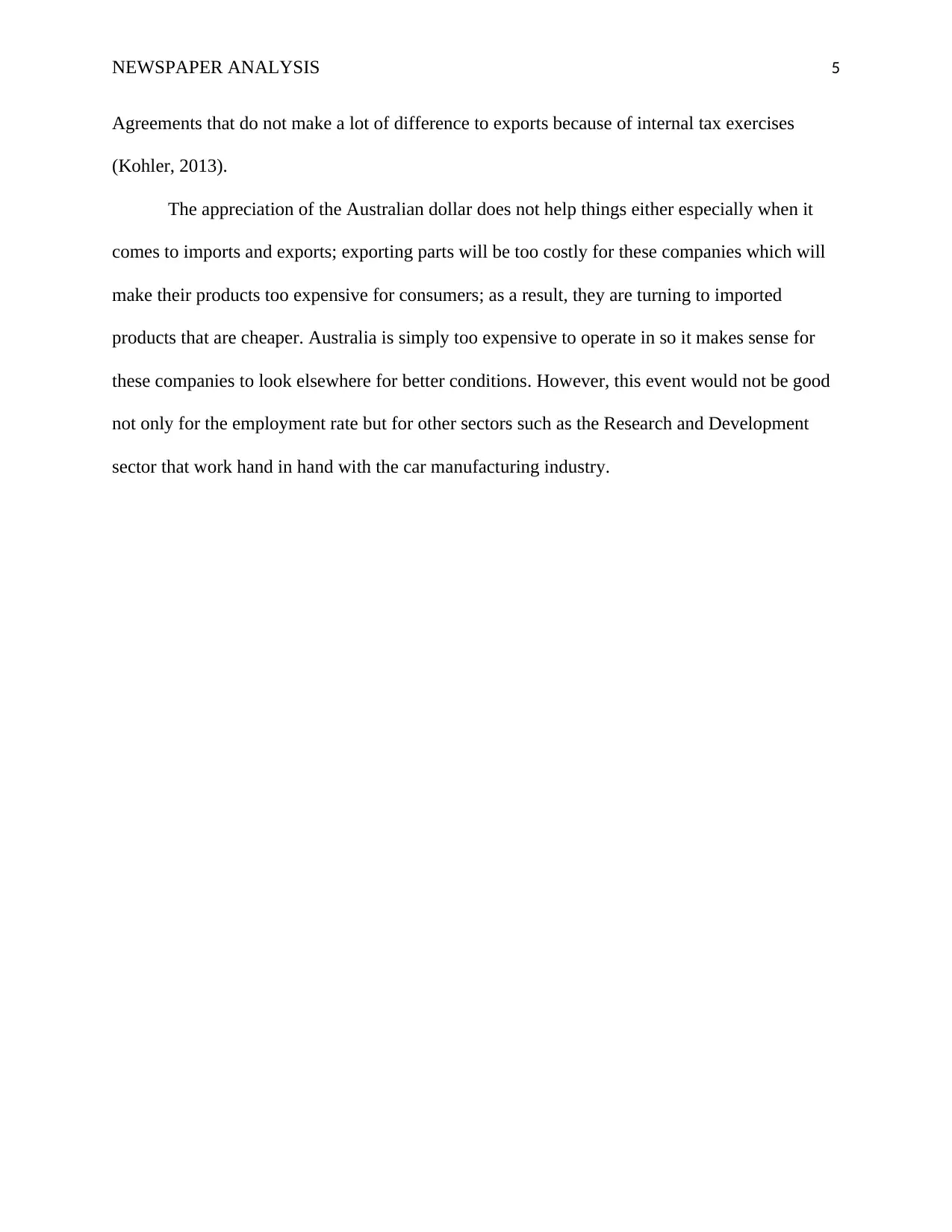
NEWSPAPER ANALYSIS 5
Agreements that do not make a lot of difference to exports because of internal tax exercises
(Kohler, 2013).
The appreciation of the Australian dollar does not help things either especially when it
comes to imports and exports; exporting parts will be too costly for these companies which will
make their products too expensive for consumers; as a result, they are turning to imported
products that are cheaper. Australia is simply too expensive to operate in so it makes sense for
these companies to look elsewhere for better conditions. However, this event would not be good
not only for the employment rate but for other sectors such as the Research and Development
sector that work hand in hand with the car manufacturing industry.
Agreements that do not make a lot of difference to exports because of internal tax exercises
(Kohler, 2013).
The appreciation of the Australian dollar does not help things either especially when it
comes to imports and exports; exporting parts will be too costly for these companies which will
make their products too expensive for consumers; as a result, they are turning to imported
products that are cheaper. Australia is simply too expensive to operate in so it makes sense for
these companies to look elsewhere for better conditions. However, this event would not be good
not only for the employment rate but for other sectors such as the Research and Development
sector that work hand in hand with the car manufacturing industry.
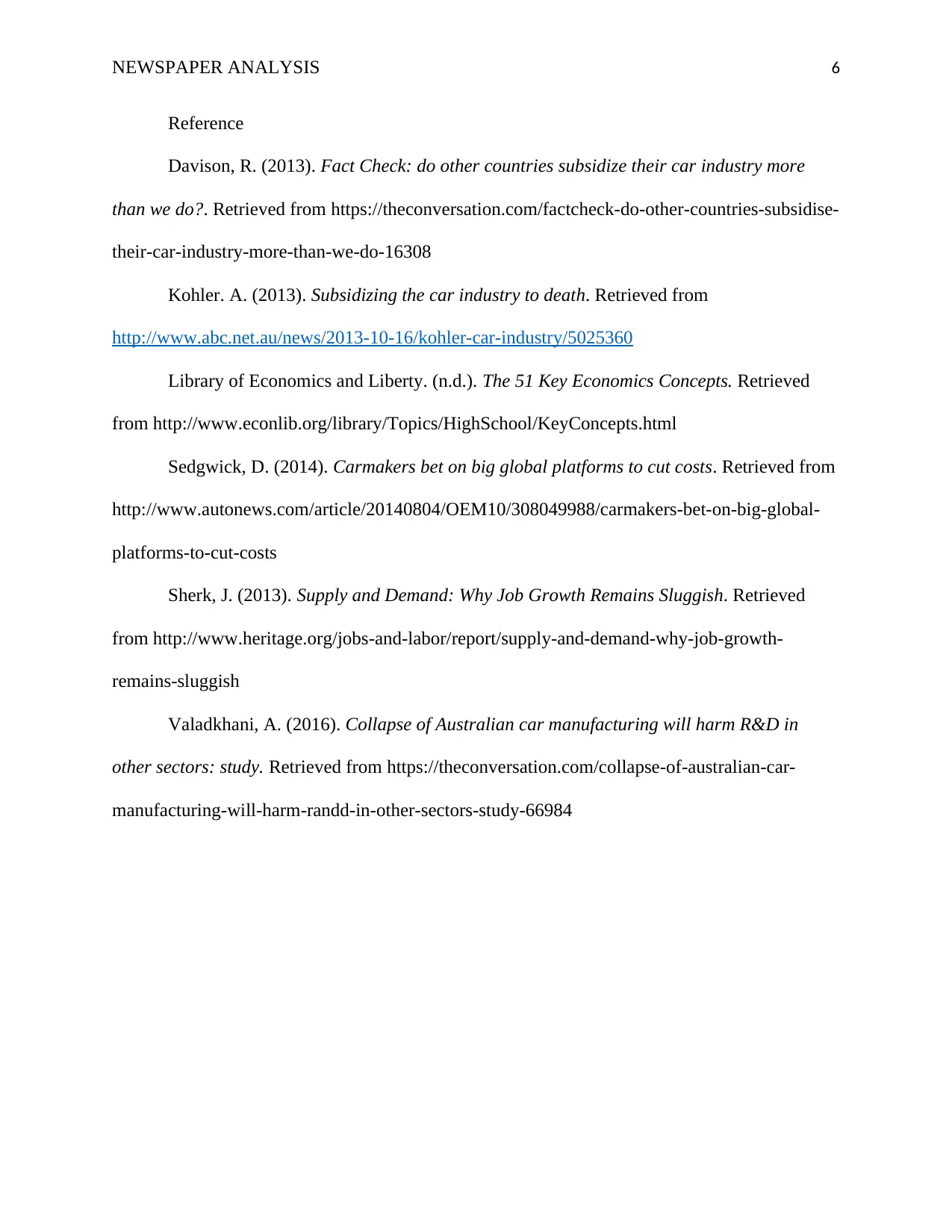
NEWSPAPER ANALYSIS 6
Reference
Davison, R. (2013). Fact Check: do other countries subsidize their car industry more
than we do?. Retrieved from https://theconversation.com/factcheck-do-other-countries-subsidise-
their-car-industry-more-than-we-do-16308
Kohler. A. (2013). Subsidizing the car industry to death. Retrieved from
http://www.abc.net.au/news/2013-10-16/kohler-car-industry/5025360
Library of Economics and Liberty. (n.d.). The 51 Key Economics Concepts. Retrieved
from http://www.econlib.org/library/Topics/HighSchool/KeyConcepts.html
Sedgwick, D. (2014). Carmakers bet on big global platforms to cut costs. Retrieved from
http://www.autonews.com/article/20140804/OEM10/308049988/carmakers-bet-on-big-global-
platforms-to-cut-costs
Sherk, J. (2013). Supply and Demand: Why Job Growth Remains Sluggish. Retrieved
from http://www.heritage.org/jobs-and-labor/report/supply-and-demand-why-job-growth-
remains-sluggish
Valadkhani, A. (2016). Collapse of Australian car manufacturing will harm R&D in
other sectors: study. Retrieved from https://theconversation.com/collapse-of-australian-car-
manufacturing-will-harm-randd-in-other-sectors-study-66984
Reference
Davison, R. (2013). Fact Check: do other countries subsidize their car industry more
than we do?. Retrieved from https://theconversation.com/factcheck-do-other-countries-subsidise-
their-car-industry-more-than-we-do-16308
Kohler. A. (2013). Subsidizing the car industry to death. Retrieved from
http://www.abc.net.au/news/2013-10-16/kohler-car-industry/5025360
Library of Economics and Liberty. (n.d.). The 51 Key Economics Concepts. Retrieved
from http://www.econlib.org/library/Topics/HighSchool/KeyConcepts.html
Sedgwick, D. (2014). Carmakers bet on big global platforms to cut costs. Retrieved from
http://www.autonews.com/article/20140804/OEM10/308049988/carmakers-bet-on-big-global-
platforms-to-cut-costs
Sherk, J. (2013). Supply and Demand: Why Job Growth Remains Sluggish. Retrieved
from http://www.heritage.org/jobs-and-labor/report/supply-and-demand-why-job-growth-
remains-sluggish
Valadkhani, A. (2016). Collapse of Australian car manufacturing will harm R&D in
other sectors: study. Retrieved from https://theconversation.com/collapse-of-australian-car-
manufacturing-will-harm-randd-in-other-sectors-study-66984
⊘ This is a preview!⊘
Do you want full access?
Subscribe today to unlock all pages.

Trusted by 1+ million students worldwide
1 out of 6
Related Documents
Your All-in-One AI-Powered Toolkit for Academic Success.
+13062052269
info@desklib.com
Available 24*7 on WhatsApp / Email
![[object Object]](/_next/static/media/star-bottom.7253800d.svg)
Unlock your academic potential
Copyright © 2020–2025 A2Z Services. All Rights Reserved. Developed and managed by ZUCOL.





